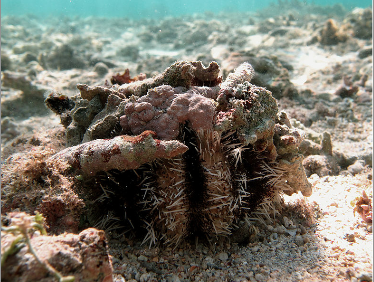Ecology
T. gratilla can occur in a variety of habitats such as; rocky shorelines, reef flats, seagrass and algal beds, and sand beds with rocks or coral. Being marine benthic organisms the urchin will spend most of its life on the ocean floor, excluding the brief planktonic lifestyle as larvae (Lawrence & Agatsuma 2007). The biogeographic distribution of the species tend to influence the location of T. gratilla in any given local environment(Lawrence & Agatsuma 2007). Byrne et al. (2004) conducted a study in the northern region of the Great Barrier Reef and found this particular species inhabiting; reef flat, intertidal reef flat, sand with coral or rubble, seagrass beds and coral outcrops. However moving to a different global location at Reunion island off the east coast of the African continent, found the species to be inhabiting back reef and oligotrophic corals (Lison de Loma et al 2004). It appears that the urchin has a number of factors influencing the choice of habitat including likelihood of predation and the availability of adequate habitats(Lawrence & Agatsuma 2007). T. gratilla are found at depths from 2-30m depending on location and are often seen covered in small masses of debris hence the name Collector urchin (Clark 1921 & Chaplin 2010). Mature urchins prefer the dwelling on the ocean floor covered in debris for concealment, while younger urchins preferring the rocky substrate for protection (Clark 1921).
Figure 1: T. gratilla covered in debris off Reunion island (http:eol.org)

Figure 2: T. gratilla covered in debris on sand and ruble substrate (http:eol.org)
More information on the location of the species at different global locations can be found in Lawrence et al. 2007. Edible Sea Urchins: Biology and Ecology.
|